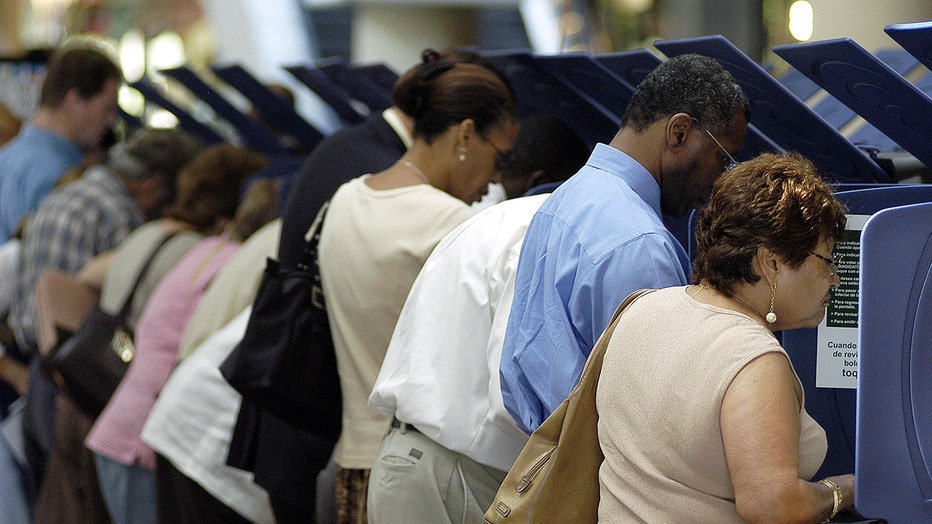Election 2020: How to protect yourself at the polls amid COVID-19 pandemic
LOS ANGELES - The United States is still in a pandemic as the 2020 presidential election draws near, leaving many worried about voting safely during the COVID-19 crisis.
Many public health experts agree that voting by mail is the safest method to avoid the risk of transmission of COVID-19, but how can people who want to vote in person stay safe?
Dr. Krutika Kuppalli, a physician with the Infectious Diseases Society of America (IDSA) and an assistant professor of medicine in the division of infectious diseases at the Medical University of South Carolina, said each state has its own rules and regulations regarding the handling of polling places on election day. IDSA is advocating for a variety of measures be put into place to reduce the risk of coronavirus transmission.

Hispanic voters go to the polls for early voting at the Miami-Dade Government Center on October 21, 2004 in Miami, Florida
“For people who can’t vote [mail-in], there’s certain steps that they can take to mediate the risk of getting coronavirus,” Kuppalli said.
Wear a mask and disinfect
Kuppalli suggests bringing personal preventative items with you to your polling place, such as your own mask and hand sanitizer.
Kuppalli said this will not only help reduce the risk of obtaining or transmitting COVID-19, but it will let people around you know that you are doing the best that you can to protect yourself and others.
IDSA is also advocating for election sites to have items such as masks and hand sanitizer available, and is urging that routine disinfection be done at polling places.
Maintain a good physical distance
“We recommend that people stay at least six feet apart,” Kuppalli said. “We’ve [IDSA] also recommended that, one of the things that election officials and voting places to do is to mark that distance, so people know they are maintaining that distance.”
RELATED: Mail-in and absentee ballots: How to ensure yours is properly filled out and doesn’t get rejected
Fill out a sample ballot before arriving
Kuppalli recommended filling out a sample ballot before arriving at your polling destination.
By knowing who you are voting for ahead of time, you can be quicker and more efficient at your polling site, Kuppalli added.
“However long we are exposed to the coronavirus, that increases our risks of getting it. So, the less time we have to wait in line at the polls, that will be hugely important,” Kuppalli added.
Head to the polls at off-peak hours
Kuppalli suggested heading to the polls when there are less people.
“We’ve recommended that people try to show up early on election day, and if possible to show up at off peak voting times — so that might mean early in the morning,” Kuppalli noted.
She also recommended going alone to vote if that is possible — the less people gathered at the polls, the safer the process will be.
In addition, IDSA is advocating for more polling places, which would reduce the density of people at each location. Then there wouldn’t be as many voters at one particular site and people would not need to wait in as long of lines.
Try to reduce your risk of transmission leading up to the 2020 election
Continuing to follow CDC guidelines, such as wearing a mask, washing hands and maintaining social distance leading up to the election, will help reduce potential spread of the coronavirus, Kuppalli said.
Kuppalli said IDSA is also advocating for free testing after the election.
“We’re recommending that free testing be available for people in the aftermath of the election, because we want to make sure that people who may be exposed be able to get tested. That’s all very important,” Kuppalli said.
What if I have been exposed to COVID-19?
IDSA has advocated that polling places have contingency plans set up, because as much as we plan “people may be coming to the polling sites sick,” Kuppalli said.
IDSA advocated that all polling places have contingency plans in place such as curbside voting, which would decrease the risk of exposure for both voters and poll workers.
Kuppalli suggested checking in with your local election officials to find of your county’s contingency plan, because every locality will have different plans in order.
Is it safe to volunteer to be a poll worker?
“This is the year that we need everybody who can be a poll worker to please come out and volunteer to be a poll worker,” Kuppalli said.
IDSA is advocating that people in younger age groups, who have less risk of serious illness, choose to volunteer on Election Day.
RELATED: USPS launches website providing resources and information on mail-in ballots ahead of 2020 election
If you have questions about your risk in being a poll worker, Kuppalli said you should check in with your health care provider.
Utilize mail-in voting if possible
“There’s no such thing as zero risk,” Kuppalli said. “They’re all things that we can do to mitigate our risk.”
Kuppalli said that mail-in voting is still the safest way to vote in terms of reducing risk for coronavirus transmission.
“If people can do mail-in voting, then they should. It’s the safest way from a COVID transmission standpoint to decrease their risk of getting COVID,” Kuppalli said.




